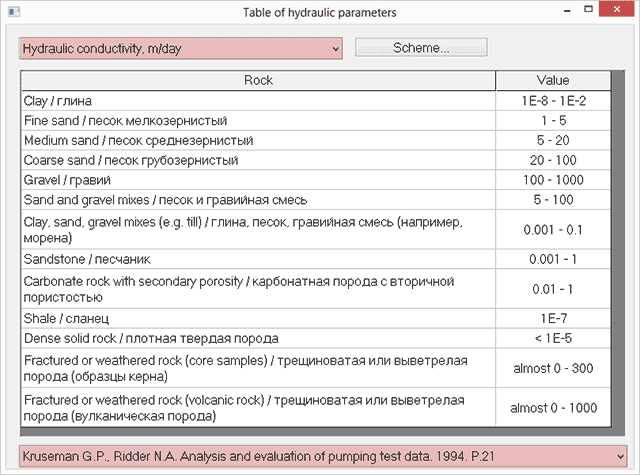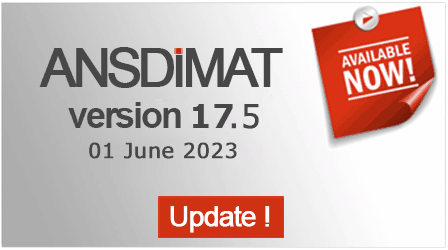AnsQuick: a set of online calculators for quick estimates of drawdown, inflows, mounding and other factors that are useful in planning pumping tests, dewatering or water supply
Drawdown calculator

AnsQuick is indispensable for the planning of pumping tests. The module contains a set of templates for standard hydrogeological conditions. The templates facilitate the quick assessment of drawdown in an observation well during a pumping test. This enables determination of the optimal discharge rate and the distance between wells during pumping tests, so the required drawdown for a specified time is obtained.
AnsQuick is a simplified versions of AnsTest and AmWells. It does not have the advanced graphical tools of AmWells or interpretation capabilities of AnsTest but it allows a quick assesment of preliminary data. The module is designed for the Windows operating system..
Radius of influence
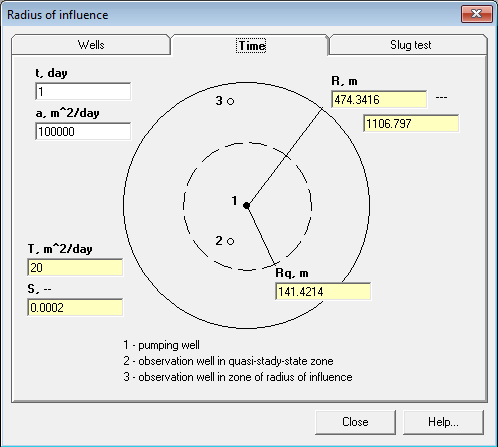
Calculates the radius of influence for a pumping test, a slug test or a production borehole. Radius of influence is determined either from drawdowns in two wells or hydraulic diffusivity and time since the start of pumping. Calculations can be conducted for confined, unconfined and confined-unconfined aquifers.
Groundwater mound
Combines several analytical solutions for groundwater mounding caused by local recharge. This tool is used for calculations of groundwater mounding from locally concentrated transient recharge in infinite aquifers or from steady state recharge in circular or strip aquifers. Calculations can be used for prediction of groundwater level rise under infiltration basins or for assessing impact of recharge during aquifer tests.

Stream-aquifer interaction
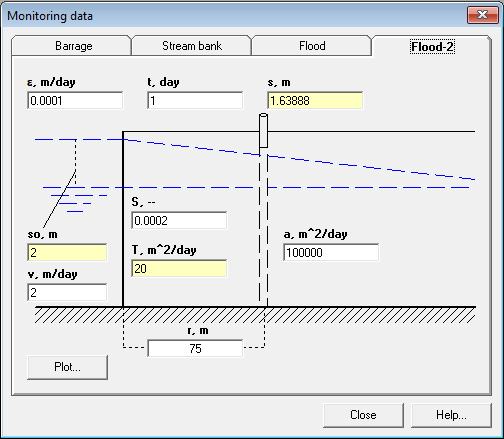
Determination of hydraulic properties of the river bed based on monitoring of groundwater levels near a river or lake/pond. This solution requires monitoring of water levels in two wells near a river. The tool can also be used to calculate the impact of water level rise in a pond/river on the aquifer water levels. In the latter case, information about hydraulic properties of the river bed is required.
Inflow and drains
This tool is used for calculations of inflow and drawdowns for open pits, underground mines, trenches and tunnels for a variety of conceptual models. Inflow to open pits and underground mine stopes is calculated using the “big well” approach, where a pit is approximated by a well with the effective radius of an open pit. Inflow to underground declines or horizontal wells is predicted using the drawdown superposition principle for a line of vertical wells (drains) with screen lengths that are equal to the dimensions of a decline or the radius of a horizontal well.

Infiltrometer tests
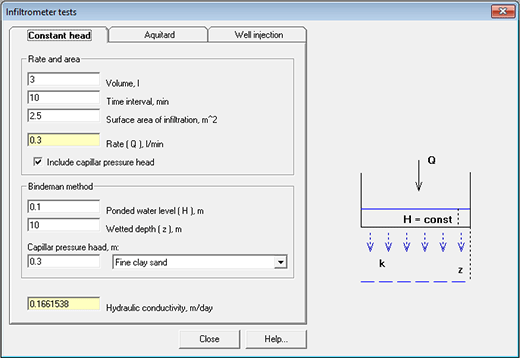
Determination of unsaturated zone hydraulic conductivity based on the two methods. The first method involves keeping constant water level in a test pit located within the unsaturated zone. Hydraulic conductivity is calculated using recorded injection rate. The second method requires a test well penetrating the top of the low-permeable layer. Water is instantaneously injected in a well and water level changes are recorded.
Lugeon test:
Interpretation of lugeon tests (packer tests). The tool includes bar diagrams of lugeon values for each pressure step and plots of water injection rates against pressure values. These plots and diagrams allow to determine testing conditions (i.e. laminar flow, turbulent flow, opening of fractures, washing out fine material or filling in fractures). Hydraulic conductivity values are calculated by Moye, Thiem and Lugeon formulas.

Slug test
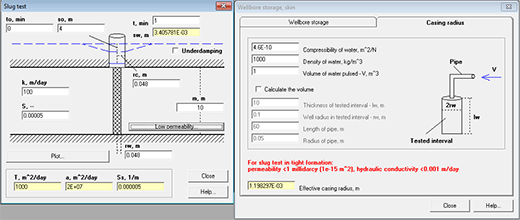
Prediction of water level drawdown or recovery during slug tests using solutions of Cooper and Picking. The tool can be used for planning slug tests).
Well efficiency calculator:
Interpretation of step-drawdown tests and calculations of well efficiency for planning constant pumping rate aquifer tests. Well efficiency and related pumping rate are calculated automatically, based on straight line displacement on the plot (s/Q) - Q.
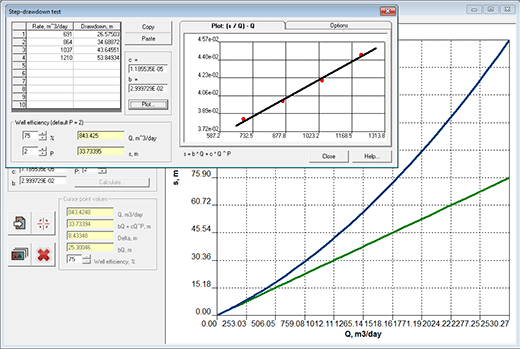
Parameter calculator
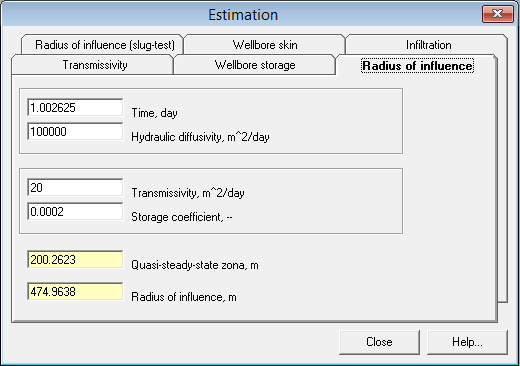
The calculator contains the parameters that are commonly used by hydrogeologist:
– Radius of influence of pumping test
– Radius of influence of slug-test
– Transmissivity evaluation (using specific discharge rate)
– Wellbore storage and Wellbore skin
– Leakage factor
– Compressibility
– Retardation coefficient.
Unit conversions for:
Convertation is available for the following parametres:
– Hydraulic conductivity
– Transmissivity
– Permeability
– Rate
– Pressure
– Density
– Viscosity
– Temperature
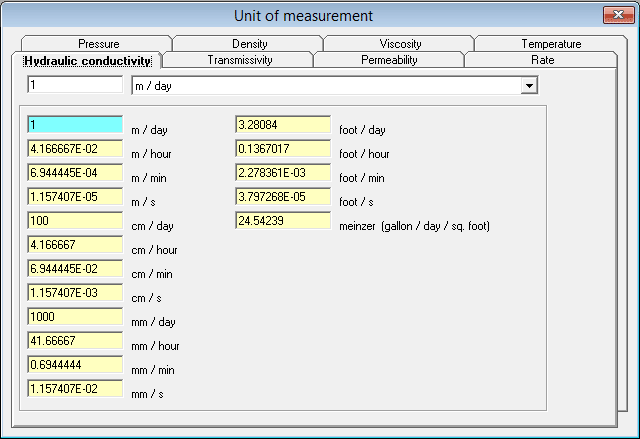
Special functions calculator

Calculations of special mathematical functions that are commonly used by hydrogeologist:
– Well function, W(u)
– Leaky aquifer function, W(u, b)
– Function of Bolton, Fb (u, b)
– Well function for a well of finite diameter , F (u, b)
– Function of slug test, Fs (u, b)
– Error function integral
– Bessel functions and other
Base of hydraulic properties
Utility includes the list of hydraulic properties of aquifers and aquitards that are reported in the literature (based on pumping tests data).
Base is available for the following parametres:
– Hydraulic conductivity
– Storage coefficient
– Specific yield
– Hydraulic diffusivity (confined & unconfined aquifer)
– Porosity
